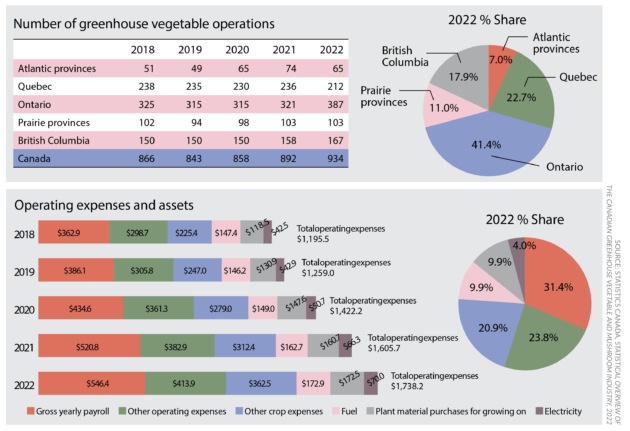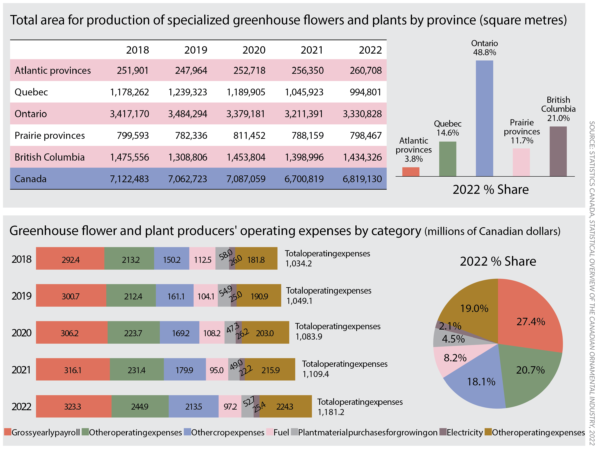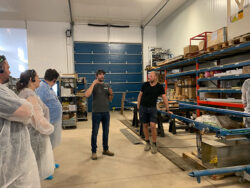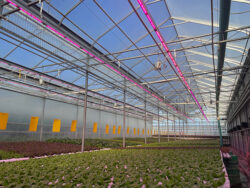
Features
Innovation in the face of adversity
Opportunities and challenges for Canadian greenhouse growers in 2024
January 8, 2024 By Amy Kouniakis
 The tradeshow floor at the 2023 Canadian Greenhouse Conference held in Niagara Falls, Ont., in October 2023, where thousands in the industry gathered for two days of education and networking.
PHOTO: Amy Kouniakis
The tradeshow floor at the 2023 Canadian Greenhouse Conference held in Niagara Falls, Ont., in October 2023, where thousands in the industry gathered for two days of education and networking.
PHOTO: Amy Kouniakis For an industry that aims to have precise control over the products it produces, it is greatly susceptible to a number of social, economic, environmental and even geopolitical forces that are entirely uncontrollable.
The way in which growers produce is becoming increasingly sophisticated, streamlined and sustainable but the rising cost of inputs – energy, labour, packaging, trucking, etc – continues to climb as a result of these outside pressures.
It’s these continuously rising costs that many in the industry say is one of the biggest challenges for modern greenhouse operations in Canada.
Economic hurdles
“The high cost of inflation – increasing the cost of everything and having an impact on consumers’ disposable income – that squeeze is being felt across the whole sector,” said Michel Benoit, CEO of B.C.’s United Flower Growers Co-operative Association (UFG). “Budgets, for things like flowers, are shrinking and consumers are definitely being more cautious.”
According to the Statistics Canada report, ‘Recent developments in the Canadian economy: Fall 2023’, inflation has eased in 2023, while prices continued to rise. “The cumulative pace of price growth over the first eight months of 2023 was similar to that observed during the first eight months of 2021, when inflationary pressures were beginning to build,” the report notes. “Overall consumer prices, measured month over month, rose steadily from January to August 2023, and were 3.7 per cent higher in August than at the end of 2022. In comparison, cumulative price growth over the first eight months of 2021 was 3.8 per cent.”
In Quebec, the ornamental sector has experienced similar trends and consumer attitudes in the face of such economic upheaval.
“Consumers are entering a period of uncertainty with sharply rising interest rates, soaring inflation and global conflicts,” said Michel Senécal, Quebec-based agronomist and greenhouse consultant. He cites the ‘Barometer 2022 of responsible consumption’ report that found “Quebecers have restricted their purchases of goods and they choose fewer local products that they perceive as expensive. In addition, according to this publication, there is a stagnation in gardening and DIY.”
Despite the uncertainty, the floriculture sector has seen some positive export activity over the past several years, a trend some see as continuing into the foreseeable future.
“Nationally, exports have risen by 45 per cent between 2020 and 2022, and trends indicate that growth will continue at the conclusion of 2023,” said Andrew Morse, Executive Director of Flowers Canada Growers Inc. “Growers who export have been finding opportunity to expand their business. At the conclusion of 2022, Canada reached over $800 million in exports, largely to the United States.”
The financial squeeze mentioned above is not only being felt in the floriculture industry, as fruit and vegetable growers are certainly feeling the pinch of rising costs but in a subtly different way.
Jan VanderHout, president of Fruit & Vegetable Growers of Canada (FVGC) claims that while much of the greenhouse vegetable and fruit crops grown are being sold, because consumer demand remains high and continues to climb, growers are in a precarious position when it comes to expanding to meet that demand.
“On a positive note, we haven’t seen a lack of demand and the products we’re growing are being sold,” he says. “It is becoming more evident that there’s not enough infrastructure – water, natural gas, electricity – to support greenhouse expansion in many parts of Canada.”
Even if the infrastructure was in place, the costs associated with building greenhouses have risen to a point where it has become prohibitive. “Growers need to know that they’ll have that return on investment,” VanderHout maintains.
Alberta greenhouse growers have had a slightly different year when it comes to expansion. According to the Alberta Greenhouse Growers Association (AGGA), for the first time ever, the vegetable sector in that province, which grew by 38 per cent compared to 2021, outpaced the ornamental sector.
“[One of our biggest successes this year] has been greenhouse expansion, especially of the vegetable sector, and it is primarily triggered by increase in population,” said Dr. Mohyuddin Mirza, a long-time member of AGGA’s board and renowned greenhouse consultant. “Most of the new greenhouses for vegetable production are state of the art for climate control and crop handling.”
He does note, however, that the rising cost of inputs may put a damper on growth for the foreseeable future.
“Energy prices including both of electricity and natural gas is a ‘chronic’ issue. Heating and dehumidification costs have increased significantly,” Mirza says. “This has affected winter production schedules and growers are thinking of reducing use of supplemental lights.
“All input costs across the board have increased, but prices have not increased. Alberta growers are still price takers and not price makers,” he said, adding that he sees 2024 as a year where the industry will be in ‘stabilizing mode’ as prices, hopefully, do just that.

Financial health
A recent report on ‘Farm Financial Health’ from the Canadian Federation of Agriculture, notes:
“The net income for Canadian farmers fell 8.3 per cent in 2022, because the growth in expenses outpaced the rise in farm income; and total farm operating expenses (after rebates) increased by 21.2 per cent in 2022, the largest gain since 1974 (+22.0 per cent).
“The agricultural sector, being capital intensive, is particularly sensitive to changes in interest rates, which influence borrowing, spending, and investment decisions,” the report states. “In 2022, the total farm debt in Canada rose to a record $138 billion, with Ontario, Alberta, and Quebec bearing the highest level of debt, with Ontario leading at $35.7 billion, followed by Alberta at $29.8 billion, and Quebec at $27.2 billion.”
As of writing, the key interest rate in Canada remains at five per cent. The Bank of Canada has warned, however, that rate hikes are still a possibility if inflation continues to rise.
Economists and members of the greenhouse industry are hopeful that, in light of the fact the inflation rate in Canada declined to 3.8 per cent in September 2023 from four per cent in the previous month, the Bank of Canada (BoC) will hold off on rate hikes for the time being. In its ‘Monetary Policy Report for October 2023,’ the BoC projects that inflation will remain in the 3.5 per cent range until mid-2024.
Going into 2024, much work is being done to address some of the financial concerns of agricultural producers. Most notably in the push to advance Bill C-280, the Financial Protection for Fresh Fruit and Vegetable Farmers Act, which, if passed, would establish a deemed trust mechanism for fresh produce growers and sellers in Canada, ensuring payment in the case of buyer bankruptcy.
A lot of work has also gone into advocating for the approval of Bill C-234, which is slowly making its way through the Canadian senate. The legislation, if passed, would exempt natural gas and propane used on farms from the federal carbon tax. As of writing, passage of the contentious bill was delayed once more as the Senate debated and voted against a last-minute amendment that could have excluded greenhouses from the exemption.

Labour woes
Even if the interest rate holds and inflation eases, aside from rising costs, one of the biggest challenges keeping growers up at night is the scarcity of labour.
“Growers are having to find ways to deal with labour shortages,” notes Benoit. “We’ve seen instances where some growers have product not getting potted and plug trays with viable product behind because there’s not enough people.
“This makes it incredibly difficult to plan for the next year because you don’t know how many employees you’ll find.”
Overall, an agri-food workforce shortfall is predicted to reach more than 123,000 jobs by 2029, states the ‘Innovation Report 2022-2023,’ from the Vineland Research and Innovation Centre.
“At the same time, labour-intensive horticultural crops increase the cost of labour, often representing 40 to 60 per cent of production costs for growers,” the report notes.
“Canada is the world’s fourth largest cucumber exporter at over $320 million annually. The potential for growth in the greenhouse vegetable industry is significant; however, the cost and restricted availability of workers are holding the sector back. Cucumbers are harvested by hand and growers spend approximately $27 million annually just on this labour-intensive task.”
Thus, the push is on to find ways to attract and retain skilled workers and to determine processes that allow growers to do more with less. It is a challenge that presents a unique opportunity for the Canadian greenhouse sector to find innovative solutions and perhaps become a global leader in developing a more sustainable means of production.
Automation will play an important role in addressing the labour gap. Operations are already finding ways to automate parts of their production process, but, according to Vineland’s ‘Automation Showcase’ report, published in March 2023, full-scale solutions are still several years off and the costs associated with adaptation remain too steep to demonstrate ROI.
Innovation and adaptation are at the heart of some important developments in the industry over the past 12 months.
Onward and Upward
“Consumers are becoming more sensitive to the use of plastic packaging and containers. They want to buy products with as little plastic as possible,” said Senécal. “The production of flowers and vegetable and herb plants in biodegradable containers is starting to gain more and more importance in retail markets.”

Jon Kamstra (left) of Bold Robotics Solutions, and Rodney Bierhuizen of Sunrise Greenhouses, speak to attendees of the Canadian Greenhouse Conference bus tour about automation and innovation.
Photos: Amy Kouniakis
This development is still in its early days and wide-scale adoption of non-plastic packaging is still a work in progress. VanderHout notes that while consumers and growers alike have wanted more environmentally friendly packaging for years, there have been ongoing discussions between producers and levels of government to find a solution that is environmentally and economically sustainable that maintains the quality of the products contained therein.
In fact, in November 2023, the FVGC, alongside the Canadian Produce Marketing Association, met with policymakers and parliamentarians in Ottawa for Fall Harvest 2023, an annual advocacy event to push for “The adoption of sustainable packaging initiatives that ensure all Canadians have access to safe food, align with international standards for sustainability and competition, and mitigate any unintended environmental impacts from the food supply’s packaging needs,” an update on the FVGC website said.
“There’s an opportunity to be innovative here and there’s still a lot of work ahead of us, but it’s moving forward,” VanderHout said.
Another important trend over the past 12 months has been, according to Mirza, “knowledge capital gains,” facilitated by industry events that, with the pandemic isolation years behind us, are back in their entirety with full rosters of education sessions and bus tours designed to educate and connect members of the industry.
“A very innovative Greenhouse Chat program has been organized by the AGGA which is recorded and made available to anybody interested,” Mirza said. “It is held from February to June via Zoom where growers share their happenings, production issues, marketing strategies.
“Many ornamental growers hold regular workshops for public, yoga classes and other events which promotes the knowledge and education of greenhouses and keep staff employed.”
He also points to “vibrant educational programs” at institutions like Lethbridge College – which recently introduced its one-year greenhouse technician program, and Olds College, renowned for its agricultural programs.
On the horizon
For all of the significant challenges growers and greenhouse operations have faced this past year, there is some hope for what is to come in 2024. In fact, for many, these challenges become an opportunity.

Leafy greens at Gull Valley Greenhouses in Lacombe Couty, Alta. This was one of six stops on the Green Industry Show and Conference bus tour in November 2023.
Photos: Amy Kouniakis
“We know that challenges become opportunities,” says Mirza. “On the energy front, the industry will be watching closely on alternate fuels. Developing technologies for fuels like hydrogen, compressed air heat extraction and others will provide opportunities.”
Mirza also points to Alberta’s recent uptick in vegetable production as a result of the increasing population as positive sign of things to come. “With the increase in population, especially the ethnic market, offers a great opportunity.”
The expanding export market and even the persistence of COVID trends will continue to have an impact on the industry.
“We saw exports growing through 2023 and there’s some feeling that we can maintain that,” noted UFG’s Benoit. “I feel we have a well-educated consumer base from COVID. They’ve learned the value of having flowers and a garden. Yes, they’re getting squeezed but I do believe that’s a short-term trend and they’ll want to come back. We’re hopeful for a great spring.”
“While financial pressure may encourage people to spend less, how they choose to do so may very much impact the performance of the sector,” adds Morse. “When consumers were unable to travel through COVID-19, many people chose to invest more heavily in their garden – this translated into one of the best financial years on record for many farms. No-one has a crystal ball, but I don’t think we can be sure how next year will end, yet.”
In Quebec, the provincial government has prioritized the expansion of greenhouse production and has seen some progress in that area.
“The Quebec Ministry of Agriculture’s program, aimed at doubling the greenhouse production area is progressing well,” notes Senécal. “Several growers use this program to increase their production area and modernize facilities.”
Despite such a promising sign, he still urges growers to remain cautious when planning for the year ahead.
“Adjust your sales prices for 2024 to maintain your margins,” he advises. “Excess production without a contract must be avoided.”
Print this page